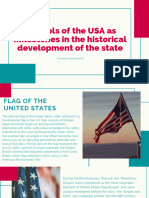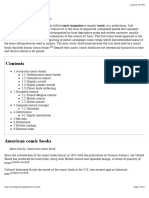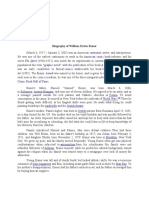0 ratings0% found this document useful (0 votes)
46 viewsThis Is A Short Presentation To Explain The Character of Uncle Sam, Made by Ivo Bogoevski
This document summarizes the character of Uncle Sam, the national personification of the United States. Uncle Sam is typically depicted as an elderly white man with white hair, goatee, and striped clothing resembling the American flag. The term originated during the War of 1812 and first appeared in literature in 1816. By the Civil War, Uncle Sam had overtaken earlier personifications like "Brother Jonathan." The iconic image of Uncle Sam pointing and declaring "I want you" was created by James Montgomery Flag for World War I recruitment in 1917. The character became a popular icon in political cartoons representing the United States.
Uploaded by
Ivo BogoevskiCopyright
© Attribution Non-Commercial (BY-NC)
Available Formats
Download as PPT, PDF, TXT or read online on Scribd
0 ratings0% found this document useful (0 votes)
46 viewsThis Is A Short Presentation To Explain The Character of Uncle Sam, Made by Ivo Bogoevski
This document summarizes the character of Uncle Sam, the national personification of the United States. Uncle Sam is typically depicted as an elderly white man with white hair, goatee, and striped clothing resembling the American flag. The term originated during the War of 1812 and first appeared in literature in 1816. By the Civil War, Uncle Sam had overtaken earlier personifications like "Brother Jonathan." The iconic image of Uncle Sam pointing and declaring "I want you" was created by James Montgomery Flag for World War I recruitment in 1917. The character became a popular icon in political cartoons representing the United States.
Uploaded by
Ivo BogoevskiCopyright
© Attribution Non-Commercial (BY-NC)
Available Formats
Download as PPT, PDF, TXT or read online on Scribd
You are on page 1/ 7
This is a short presentation to
explain the character of Uncle
Sam, made by Ivo Bogoevski.
Uncle Sam
Uncle Sam is a national personification of the
United States and sometimes more specifically of
the American government, with the first usage of
the term dating from the War of 1812. He is
depicted as a stern elderly white man with white
hair and a goatee beard, and dressed in clothing
that recalls the design elements of flag of the
United States—for example, typically a top hat
with red and white stripes and white stars on a
blue band, and red and white striped trousers.
The first use of the term in literature is seen in
an 1816 allegorical book, The Adventures of
Uncle Sam in Search After His Lost Honour by
Frederick Augustus Fidfaddy, Esq.
Earlier representative figures of the United
States included such beings as "Brother
Jonathan," used by Punch magazine. These
were overtaken by Uncle Sam somewhere
around the time of the Civil War. The female
personification "Columbia" has seldom been
seen since the 1920s. The well-known
"recruitment" image of Uncle Sam was created
by James Montgomery Flag, an illustrator and
portrait artist best known for commercial art.
The image of Uncle Sam was shown publicly for the first time,
according to some, in a picture by Flag on the cover of the
magazine Leslie's Weekly, on July 6, 1916, with the caption
"What Are You Doing for Preparedness?“ More than four million
copies of this image were printed between 1917 and 1918. The
image also was used extensively during World War II.
In the year 1812, a large quantity of
provisions for the army was purchased at
Troy, N.Y., by Elbert Anderson, a government
contractor. The goods were inspected by two
brothers, Ebenezer and Samuel Wilson. The
last named was invariably known among the
workmen as "Uncle Sam." The packages were
marked E.A.-U.S. On being asked the meaning
of these initials, a workman jokingly replied
that he didn't know unless they meant Elbert
and Uncle Sam. So, the title became current
among the workmen, soldiers, and people,
and the United States Government is now
known affectionately as "Uncle Sam"
Uncle Sam became a useful, popular icon in cartoons, much
like the John Bull character who represented the United
Kingdom, or the Uncle Lewis character who represented
France. John Bull and Uncle Sam have squared off in hundreds
of political cartoons throughout the years.
The most famous image of the Uncle Sam persona was a
World War I recruiting image that depicted a stern Sam
pointing his finger at the viewer and declaring, "I want you."
This was painted by artist James Montgomery Flag in the year
of 1917, just prior to US involvement in World War I.
You might also like
- The 'Life' & The Great Depression (In Cartoons)100% (1)The 'Life' & The Great Depression (In Cartoons)100 pages
- TO Hero:: From Fu Manchu, Evil Genius, James Lee Wong, PopularNo ratings yetTO Hero:: From Fu Manchu, Evil Genius, James Lee Wong, Popular14 pages
- Uncle Sam: This Article May Require - No Has Been Specified. Please Help If You CanNo ratings yetUncle Sam: This Article May Require - No Has Been Specified. Please Help If You Can3 pages
- Scott Comics Propaganda 5256473d62cece05434ded09eefea886No ratings yetScott Comics Propaganda 5256473d62cece05434ded09eefea88620 pages
- Remembering Camelot Hal Foster S PrinceNo ratings yetRemembering Camelot Hal Foster S Prince51 pages
- Comic Book: From Wikipedia, The Free EncyclopediaNo ratings yetComic Book: From Wikipedia, The Free Encyclopedia10 pages
- King Kong Race, Sex, and Rebellion: by David N. RosenNo ratings yetKing Kong Race, Sex, and Rebellion: by David N. Rosen5 pages
- History of American Literature: Estt. 1869No ratings yetHistory of American Literature: Estt. 186911 pages
- The Texan Triumph - A Romance of the San Jacinto CampaignFrom EverandThe Texan Triumph - A Romance of the San Jacinto CampaignNo ratings yet
- Founding Fathers: of The United States Constitution and Our Country's Early HistoryNo ratings yetFounding Fathers: of The United States Constitution and Our Country's Early History23 pages
- The Eyes of the Woods, a Story of the Ancient WildernessFrom EverandThe Eyes of the Woods, a Story of the Ancient WildernessNo ratings yet
- The Last of the Chiefs - A Story of the Great Sioux WarFrom EverandThe Last of the Chiefs - A Story of the Great Sioux WarNo ratings yet
- History of American Literature: ReportersNo ratings yetHistory of American Literature: Reporters11 pages
- Clark Ashton Smith:The Sorcerer of Auburn by Alan GulletteNo ratings yetClark Ashton Smith:The Sorcerer of Auburn by Alan Gullette9 pages
- Round-3-Elementary-Set-1-2018-2019-National-History-Bee-Regional-FinalsNo ratings yetRound-3-Elementary-Set-1-2018-2019-National-History-Bee-Regional-Finals5 pages
- A Historiographical Essay On Various Works Regarding The Life and Presidency of John AdamsNo ratings yetA Historiographical Essay On Various Works Regarding The Life and Presidency of John Adams16 pages
- History of American Literature: ReportersNo ratings yetHistory of American Literature: Reporters11 pages
- Mr. Churchill's Profession: The Statesman as Author and the Book That Defined the "Special Relationship"From EverandMr. Churchill's Profession: The Statesman as Author and the Book That Defined the "Special Relationship"4/5 (5)
- Block-4 Others American Fiction Old IGNOU DelNo ratings yetBlock-4 Others American Fiction Old IGNOU Del38 pages
- American Literature - Drama, American Themes, Forms of Melodrama, A Shift Toward Realism Drama Referat50% (2)American Literature - Drama, American Themes, Forms of Melodrama, A Shift Toward Realism Drama Referat8 pages
- "I Love Paul Revere, Whether He Rode Or Not": A Collection of Legends, Lies, & Cherished Myths of AmericanFrom Everand"I Love Paul Revere, Whether He Rode Or Not": A Collection of Legends, Lies, & Cherished Myths of American3/5 (23)
- The Good Fight: The Feuds of the Founding Fathers (and How They Shaped the Nation)From EverandThe Good Fight: The Feuds of the Founding Fathers (and How They Shaped the Nation)No ratings yet
- Hamlet Annotated Journal With Summaries1No ratings yetHamlet Annotated Journal With Summaries1175 pages
- Petitioner Vs Vs Respondents: Third DivisionNo ratings yetPetitioner Vs Vs Respondents: Third Division7 pages
- Islamist Opposition in The Islamic Republic: Jundullah and The Spread of Extremist Deobandism in IranNo ratings yetIslamist Opposition in The Islamic Republic: Jundullah and The Spread of Extremist Deobandism in Iran40 pages
- Colombia, Indice de Precios Al Consumidor (IPC) : Índices - Serie de Empalme 2003 - 2019No ratings yetColombia, Indice de Precios Al Consumidor (IPC) : Índices - Serie de Empalme 2003 - 20191 page
- The Hidden Isle - Character Sheets 1.3-fillable-7-8No ratings yetThe Hidden Isle - Character Sheets 1.3-fillable-7-82 pages
- Texto A Lost and Found: Universidades Públicas de La Comunidad de Madrid Instrucciones Generales Y ValoraciónNo ratings yetTexto A Lost and Found: Universidades Públicas de La Comunidad de Madrid Instrucciones Generales Y Valoración4 pages
- A Brief History of Korea - Mark PetersonNo ratings yetA Brief History of Korea - Mark Peterson1 page
- Phil Correction System - Current Situation and Issues75% (4)Phil Correction System - Current Situation and Issues13 pages
- Philippine Literature Under The Republic Period100% (2)Philippine Literature Under The Republic Period11 pages
- OV Form 1B - REQUEST FOR TRANSFER OF REGISTRATION RECORDNo ratings yetOV Form 1B - REQUEST FOR TRANSFER OF REGISTRATION RECORD1 page
- Begging Problem in India: By: Karuna KaranNo ratings yetBegging Problem in India: By: Karuna Karan11 pages
- Business Clearance: Barangay San Nicolas 2 BetisNo ratings yetBusiness Clearance: Barangay San Nicolas 2 Betis1 page
- Request For Judicial Notice - The Law Office of Ryan James Smythe100% (1)Request For Judicial Notice - The Law Office of Ryan James Smythe30 pages
- Curzio Malaparte - Coup D'etat - The Technique of Revolution (2004)100% (1)Curzio Malaparte - Coup D'etat - The Technique of Revolution (2004)107 pages
- TO Hero:: From Fu Manchu, Evil Genius, James Lee Wong, PopularTO Hero:: From Fu Manchu, Evil Genius, James Lee Wong, Popular
- Uncle Sam: This Article May Require - No Has Been Specified. Please Help If You CanUncle Sam: This Article May Require - No Has Been Specified. Please Help If You Can
- Scott Comics Propaganda 5256473d62cece05434ded09eefea886Scott Comics Propaganda 5256473d62cece05434ded09eefea886
- King Kong Race, Sex, and Rebellion: by David N. RosenKing Kong Race, Sex, and Rebellion: by David N. Rosen
- The Texan Triumph - A Romance of the San Jacinto CampaignFrom EverandThe Texan Triumph - A Romance of the San Jacinto Campaign
- Founding Fathers: of The United States Constitution and Our Country's Early HistoryFounding Fathers: of The United States Constitution and Our Country's Early History
- The Eyes of the Woods, a Story of the Ancient WildernessFrom EverandThe Eyes of the Woods, a Story of the Ancient Wilderness
- The Texan Scouts - A Story of the Alamo and GoliadFrom EverandThe Texan Scouts - A Story of the Alamo and Goliad
- The Last of the Chiefs - A Story of the Great Sioux WarFrom EverandThe Last of the Chiefs - A Story of the Great Sioux War
- Clark Ashton Smith:The Sorcerer of Auburn by Alan GulletteClark Ashton Smith:The Sorcerer of Auburn by Alan Gullette
- Round-3-Elementary-Set-1-2018-2019-National-History-Bee-Regional-FinalsRound-3-Elementary-Set-1-2018-2019-National-History-Bee-Regional-Finals
- A Historiographical Essay On Various Works Regarding The Life and Presidency of John AdamsA Historiographical Essay On Various Works Regarding The Life and Presidency of John Adams
- The Keepers of the Trail, a Story of the Great WoodsFrom EverandThe Keepers of the Trail, a Story of the Great Woods
- Cattle Brands - A Collection of Western Camp-Fire StoriesFrom EverandCattle Brands - A Collection of Western Camp-Fire Stories
- Mr. Churchill's Profession: The Statesman as Author and the Book That Defined the "Special Relationship"From EverandMr. Churchill's Profession: The Statesman as Author and the Book That Defined the "Special Relationship"
- American Literature - Drama, American Themes, Forms of Melodrama, A Shift Toward Realism Drama ReferatAmerican Literature - Drama, American Themes, Forms of Melodrama, A Shift Toward Realism Drama Referat
- "I Love Paul Revere, Whether He Rode Or Not": A Collection of Legends, Lies, & Cherished Myths of AmericanFrom Everand"I Love Paul Revere, Whether He Rode Or Not": A Collection of Legends, Lies, & Cherished Myths of American
- The Good Fight: The Feuds of the Founding Fathers (and How They Shaped the Nation)From EverandThe Good Fight: The Feuds of the Founding Fathers (and How They Shaped the Nation)
- Islamist Opposition in The Islamic Republic: Jundullah and The Spread of Extremist Deobandism in IranIslamist Opposition in The Islamic Republic: Jundullah and The Spread of Extremist Deobandism in Iran
- Colombia, Indice de Precios Al Consumidor (IPC) : Índices - Serie de Empalme 2003 - 2019Colombia, Indice de Precios Al Consumidor (IPC) : Índices - Serie de Empalme 2003 - 2019
- The Hidden Isle - Character Sheets 1.3-fillable-7-8The Hidden Isle - Character Sheets 1.3-fillable-7-8
- Texto A Lost and Found: Universidades Públicas de La Comunidad de Madrid Instrucciones Generales Y ValoraciónTexto A Lost and Found: Universidades Públicas de La Comunidad de Madrid Instrucciones Generales Y Valoración
- Phil Correction System - Current Situation and IssuesPhil Correction System - Current Situation and Issues
- OV Form 1B - REQUEST FOR TRANSFER OF REGISTRATION RECORDOV Form 1B - REQUEST FOR TRANSFER OF REGISTRATION RECORD
- Request For Judicial Notice - The Law Office of Ryan James SmytheRequest For Judicial Notice - The Law Office of Ryan James Smythe
- Curzio Malaparte - Coup D'etat - The Technique of Revolution (2004)Curzio Malaparte - Coup D'etat - The Technique of Revolution (2004)

























































































